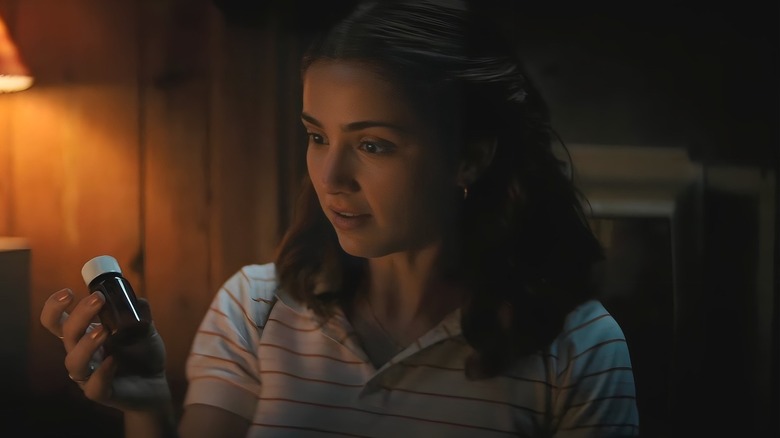Fear Street Part 2: The L484 Pill Explained
Netflix's "Fear Street" trilogy was a fresh approach to a slasher series. Blending classic camp horror with bloody kills and storytelling that took the audience back in time was a considerable risk, but it paid off. Fans loved the teen scream films that paid homage to the classic slashers that came before, this time dipped in supernatural horror.
"Fear Street Part Two: 1978" might be the most predictable of the films. Set in a summer camp that hosts kids from both Sunnyvale and Shadyside, the main killer of "1978" is corrupted counselor Tommy (McCabe Slye), who uses an ax and ends up with a sack for a creepy mask. The parallels to "Friday the 13th" are strong in this film, but it has quirks that help it stand on its own. However, one of the oddest things to come out of this film is the L484 pill.
Cindy (Emily Rudd), a camp counselor and one of the main characters, finds the L484 pills in Nurse Lane's (Jordana Spiro) office after the woman is arrested for trying to kill Tommy. Upon seeing the pills, Cindy believes they might be responsible for Nurse Lane's random breakdown. Cindy's assumption, combined with Alice's (Ryan Simpkins) stealing the pills to get high, led audiences to believe the drug was dangerous.
L484 is just acetaminophen, a safe and mild over-the-counter medication used to ease minor aches and pains as well as reduce fever. One of the most common forms of this particular medicine is Tylenol.
The L484 pill is harmless, but the movie makes a fuss about it anyway
There are a number of reasons that the drug storyline could have been implemented in the film. The most obvious answer is that it's meant to represent the mentality of the time. The United States' "War on Drugs" dominated the 1970s. Even President Richard Nixon identified drug abuse as "public enemy No. 1," leading to paranoia around drug usage. This probably explains the extreme disgust of Cindy (the pure virgin main character trope) with Alice's casual use of recreational drugs and the automatic assumption that Nurse Lane must also be abusing substances. With Nurse Lane, it makes little sense to make that jump. She's a nurse. She's likely to have a range of medication in her office to treat injuries and ailments, but the L484 pill is still demonized in the film as something dangerous.
Another explanation for the fixation on this storyline could be an Easter egg referencing the Chicago Tylenol murders. In 1982, only a few years after "Fear Street Part Two: 1978" takes place, numerous deaths in Chicago were linked to Tylenol. As it turns out, these unsuspecting victims purchased a bottle of Tylenol, took it home, and consumed the medication without knowing the bottles had been tampered with. Each death was the result of Tylenol poisoned with potassium cyanide.
According to the public information about the murders, each bottle of poisoned Tylenol came from a different factory, but each death took place in Chicago. This suggests that the bottles were laced with potassium cyanide within the stores where they were sold. The person responsible for the seven deaths was never caught, and the case remains unsolved.
Drug usage is a constant throughout the trilogy
Although "Fear Street Part Two: 1978" fixates on drugs the most, every film somehow includes substance abuse. In "1978," Alice and her boyfriend can be seen smoking marijuana. Alice also steals the L484 pills in hopes of getting high with them.
In "Part One: 1994," one of the main characters, Kate Schmidt (Julia Rehwald), is portrayed as a drug dealer. Ultimately, this ends up helping when they decided that they need to temporarily kill a member of their group possessed by Sarah Fier, the witch that allegedly cursed Shadyside, and resuscitate her after to rid her of the curse. Even though her access to the drugs was beneficial, it speaks volumes that one of the main characters was unapologetically a drug dealer.
Even "Part Three: 1666" eludes to drug users with psychedelic berries. While there are a few theories buzzing around for why the trilogy emphasizes drugs so much, the most likely case is that Shadysiders are turning to drugs to help cope with the doom and gloom. Due to the curse on the land, Shadysiders can't escape their miserable futures or dreadful deaths. Nothing has freed the generations of Shadysiders since Sarah Fier's death in 1666.
It's worth noting that as time goes on and the conditions in Shadyside get worse, the drugs get harder too. "1978" mainly focuses on weed, but in "1994," it bumped up to more serious drugs like LSD.


